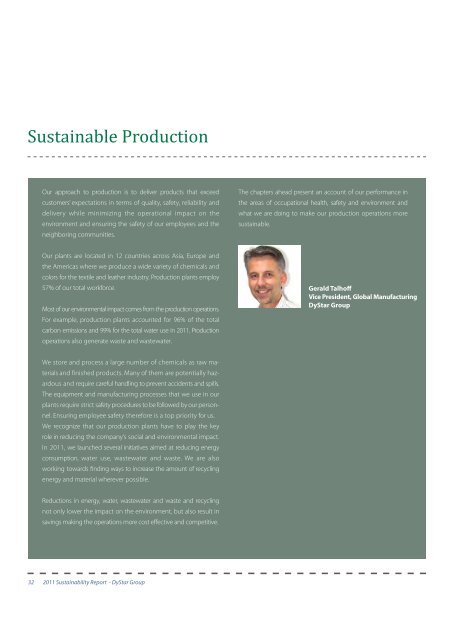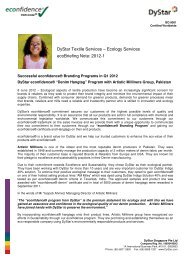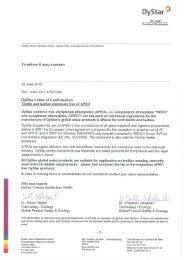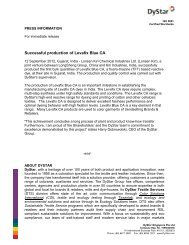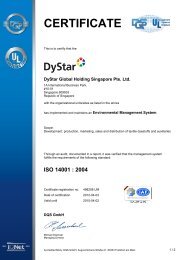Read the DyStar Sustainability Report 2011...
Read the DyStar Sustainability Report 2011...
Read the DyStar Sustainability Report 2011...
You also want an ePaper? Increase the reach of your titles
YUMPU automatically turns print PDFs into web optimized ePapers that Google loves.
Sustainable Production<br />
Our approach to production is to deliver products that exceed<br />
customers’ expectations in terms of quality, safety, reliability and<br />
delivery while minimizing <strong>the</strong> operational impact on <strong>the</strong><br />
environment and ensuring <strong>the</strong> safety of our employees and <strong>the</strong><br />
neighboring communities.<br />
Our plants are located in 12 countries across Asia, Europe and<br />
<strong>the</strong> Americas where we produce a wide variety of chemicals and<br />
colors for <strong>the</strong> textile and lea<strong>the</strong>r industry. Production plants employ<br />
57% of our total workforce.<br />
Most of our environmental impact comes from <strong>the</strong> production operations.<br />
For example, production plants accounted for 96% of <strong>the</strong> total<br />
carbon emissions and 99% for <strong>the</strong> total water use in <strong>2011.</strong> Production<br />
operations also generate waste and wastewater.<br />
We store and process a large number of chemicals as raw ma-<br />
terials and finished products. Many of <strong>the</strong>m are potentially hazardous<br />
and require careful handling to prevent accidents and spills.<br />
The equipment and manufacturing processes that we use in our<br />
plants require strict safety procedures to be followed by our personnel.<br />
Ensuring employee safety <strong>the</strong>refore is a top priority for us.<br />
We recognize that our production plants have to play <strong>the</strong> key<br />
role in reducing <strong>the</strong> company’s social and environmental impact.<br />
In 2011, we launched several initiatives aimed at reducing energy<br />
consumption, water use, wastewater and waste. We are also<br />
working towards finding ways to increase <strong>the</strong> amount of recycling<br />
energy and material wherever possible.<br />
Reductions in energy, water, wastewater and waste and recycling<br />
not only lower <strong>the</strong> impact on <strong>the</strong> environment, but also result in<br />
savings making <strong>the</strong> operations more cost effective and competitive.<br />
32 2011 <strong>Sustainability</strong> <strong>Report</strong> - <strong>DyStar</strong> Group<br />
The chapters ahead present an account of our performance in<br />
<strong>the</strong> areas of occupational health, safety and environment and<br />
what we are doing to make our production operations more<br />
sustainable.<br />
Gerald Talhoff<br />
Vice President, Global Manufacturing<br />
<strong>DyStar</strong> Group


